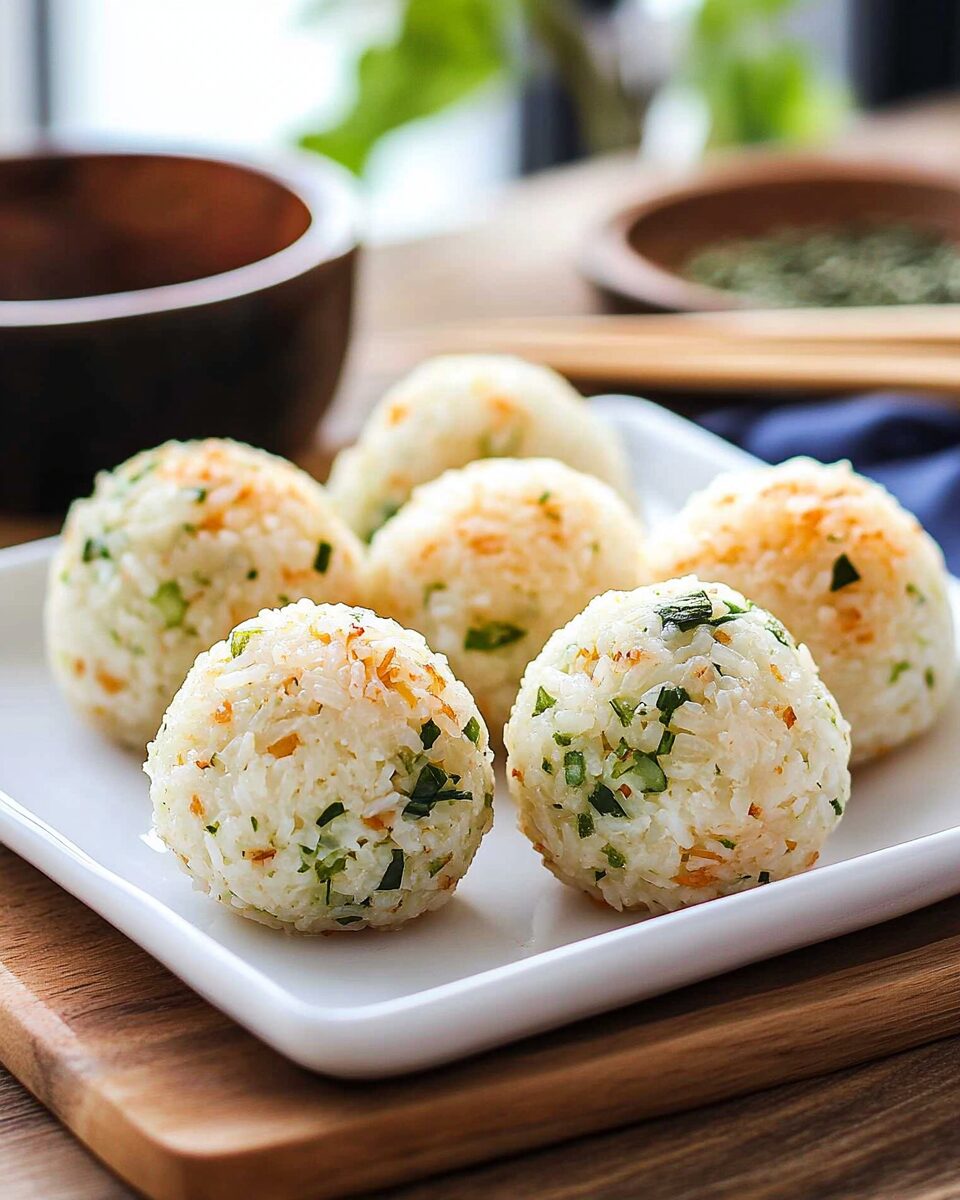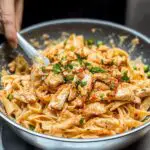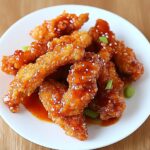Jumeokbap, meaning “fist rice” in Korean, are delicious and customizable rice balls often enjoyed as a snack, light meal, or packed lunch. These rice balls are mixed with various seasonings and fillings, making them flavorful and satisfying.
FULL RECIPE:
Ingredients
- 2 cups cooked short-grain rice (white or brown)
- 1/2 cup canned tuna (drained) or cooked ground beef
- 1/4 cup kimchi, finely chopped
- 1 tablespoon gochujang (Korean red pepper paste)
- 1 teaspoon sesame oil
- 1 teaspoon soy sauce
- 1 teaspoon toasted sesame seeds
- 1/2 teaspoon salt (to taste)
- 1/4 cup roasted seaweed (nori), finely shredded
- 1 green onion, finely chopped
- 1/2 teaspoon sugar (optional)
- Cooking gloves or plastic wrap (for shaping)
Directions
- Cook short-grain rice and let it cool slightly. It should be warm but not too hot to handle.
- In a mixing bowl, combine the rice, tuna (or ground beef), chopped kimchi, gochujang, sesame oil, soy sauce, sesame seeds, salt, seaweed, and green onion. Mix well until evenly combined.
- Take a small handful of the mixture and shape it into a ball, about the size of a golf ball. Use plastic gloves or lightly wet hands to prevent sticking.
- Repeat with the remaining mixture until all rice balls are formed.
- Serve immediately or store in an airtight container for later consumption. These can be eaten at room temperature or chilled.
Nutrition Facts
- Calories: ~180 per rice ball (varies by ingredients used)
- Carbohydrates: ~30g
- Protein: ~6g
- Fat: ~3g
- Sodium: ~400mg
- Fiber: ~1.5g
- Sugar: ~1g
- Calcium: ~20mg
- Iron: ~0.7mg
History and Cultural Significance
Jumeokbap has a long history in Korean cuisine, dating back to times when food needed to be portable and convenient. It was traditionally eaten during times of war or labor-intensive work because it was easy to carry and required no utensils. These rice balls were often made with simple ingredients like leftover rice, seaweed, and sesame oil. Over time, they evolved into a more refined dish with a variety of fillings, including meat, vegetables, and seasonings. Today, Jumeokbap is commonly found in school lunches, picnics, and even Korean restaurants, showcasing its adaptability and cultural importance. In Korean households, Jumeokbap is often prepared as a fun and interactive meal, especially for children. Families gather around to mix ingredients and shape the rice balls together, making it an enjoyable cooking experience.
Variations and Popular Ingredients
Jumeokbap is highly customizable, making it an excellent dish for using up leftover ingredients. Some of the most popular variations include tuna mayo Jumeokbap, which consists of seasoned tuna mixed with mayonnaise and sometimes a touch of wasabi or mustard for extra flavor. Another popular version is kimchi Jumeokbap, where finely chopped, well-fermented kimchi is mixed into the rice, adding a spicy and tangy kick. Other variations include beef Jumeokbap, where seasoned ground beef is mixed with rice to create a more protein-rich option. There is also vegetarian Jumeokbap, which incorporates ingredients like sautéed mushrooms, shredded carrots, and spinach for a healthier alternative. Seaweed Jumeokbap is another favorite, where shredded roasted seaweed (gim) is mixed into the rice, giving it a slightly salty and umami-rich flavor. The seasonings used in Jumeokbap can vary depending on the desired taste. Sesame oil is a must-have ingredient, providing a nutty aroma and helping to bind the rice together. Soy sauce, gochujang (Korean red pepper paste), and salt are commonly used to enhance the flavor. Some people also add a sprinkle of sugar to balance out the savory notes.
Pairing and Serving Suggestions
Jumeokbap is often served as a side dish or a light meal. It pairs well with a variety of Korean dishes, such as tteokbokki (spicy rice cakes), kimchi jjigae (kimchi stew), or Korean fried chicken. These rice balls can also be served with simple dipping sauces like soy sauce mixed with a bit of sesame oil, or a spicy gochujang-based sauce. For those looking to make a complete meal, Jumeokbap can be enjoyed with a bowl of miso soup, a fresh salad, or some pickled vegetables. It also makes a great addition to kimbap platters, adding variety to a Korean-inspired meal. When preparing Jumeokbap for a picnic or lunchbox, they can be wrapped individually in plastic wrap or stored in an airtight container to maintain freshness.
Health Benefits and Nutritional Value
Jumeokbap is not only delicious but also offers nutritional benefits. The main ingredient, rice, is a good source of carbohydrates, providing energy and keeping you full for longer. Short-grain rice, commonly used in this dish, has a slightly sticky texture that helps the rice balls hold their shape while being easy to digest. The inclusion of protein-rich ingredients such as tuna, beef, or eggs makes Jumeokbap a well-balanced meal. Additionally, vegetables like kimchi, carrots, and spinach add vitamins and minerals that contribute to a healthy diet. Kimchi, a popular ingredient in many variations of Jumeokbap, is fermented and contains probiotics that support gut health. Sesame seeds and sesame oil provide healthy fats and antioxidants, promoting heart health and reducing inflammation. While Jumeokbap is generally nutritious, the calorie content can vary depending on the ingredients used. Using lean protein options and incorporating more vegetables can make this dish even healthier. For those looking for a lighter version, brown rice can be used instead of white rice to increase fiber content and improve digestion.
Why You Should Try Jumeokbap
Jumeokbap is an excellent dish for anyone who enjoys Korean flavors or wants to try an easy-to-make, versatile meal. It requires minimal cooking skills, making it ideal for beginners or those who need a quick, hassle-free meal. The customization possibilities allow for endless flavor combinations, ensuring that there is a Jumeokbap recipe for everyone.
Conclusion
Korean Rice Balls (Jumeokbap) are a simple yet flavorful dish that embodies the heart of Korean home cooking. Their history, cultural significance, and versatility make them a staple in many households, offering a delicious and practical meal solution. Whether you prefer a classic tuna or beef filling or want to experiment with vegetarian options, Jumeokbap is an easy and fun way to enjoy Korean cuisine. Their portability, nutritional benefits, and customizability make them perfect for any occasion.






